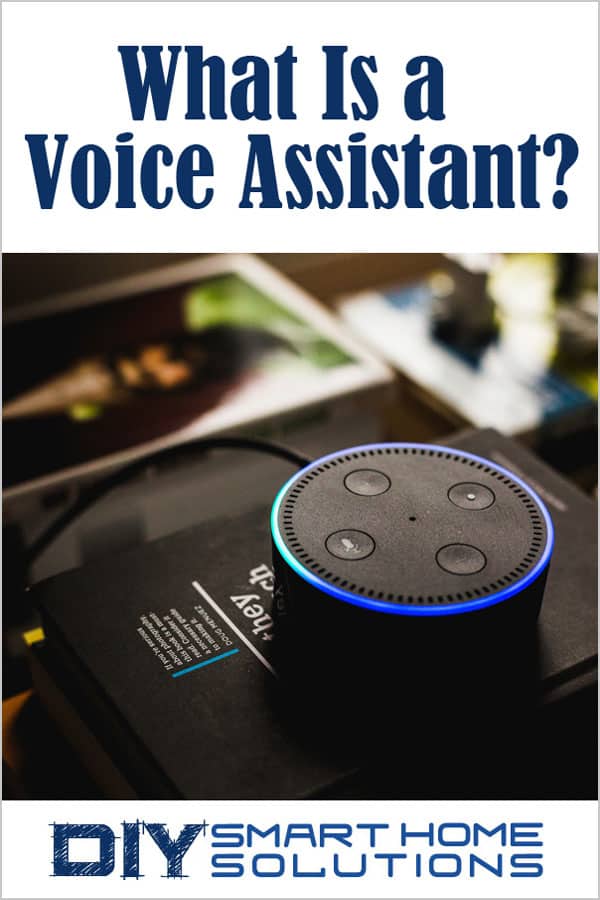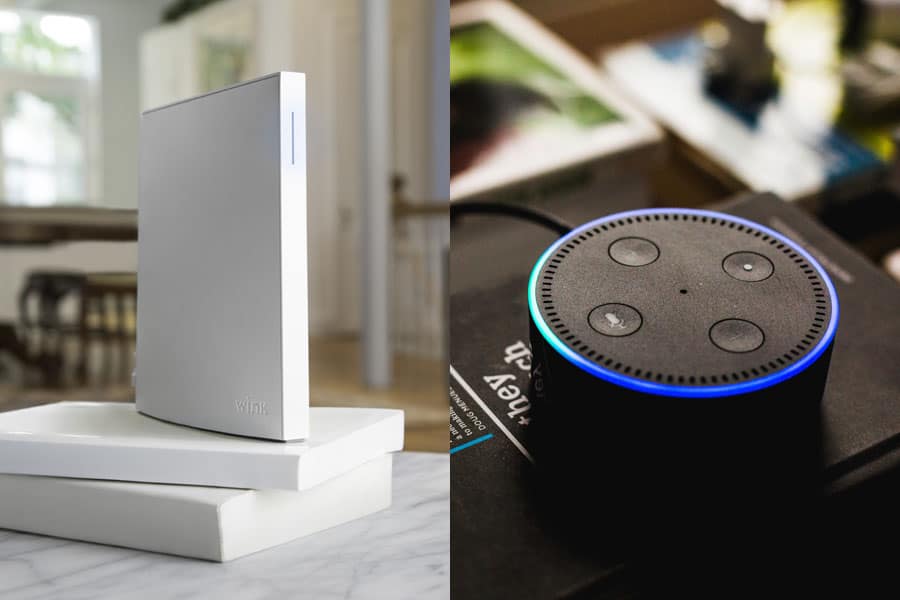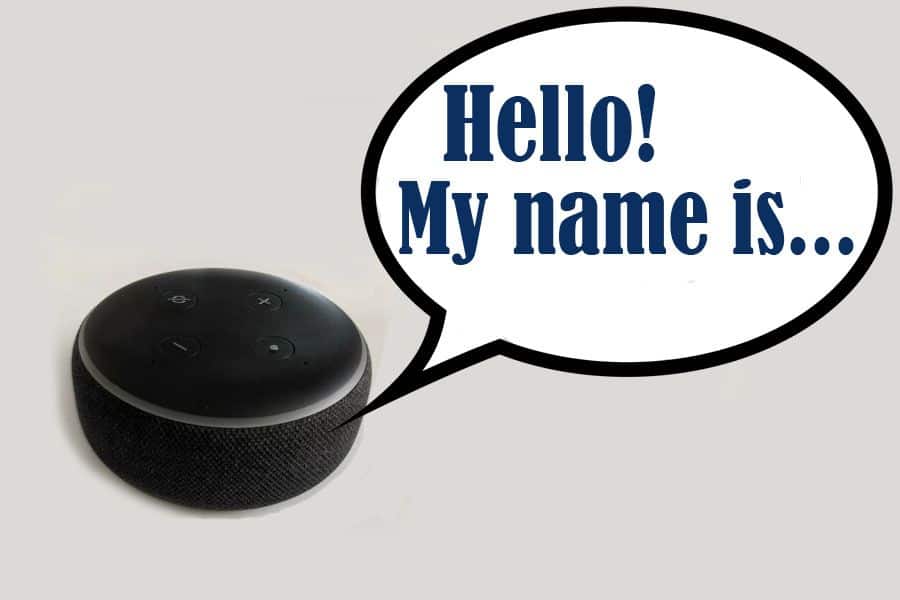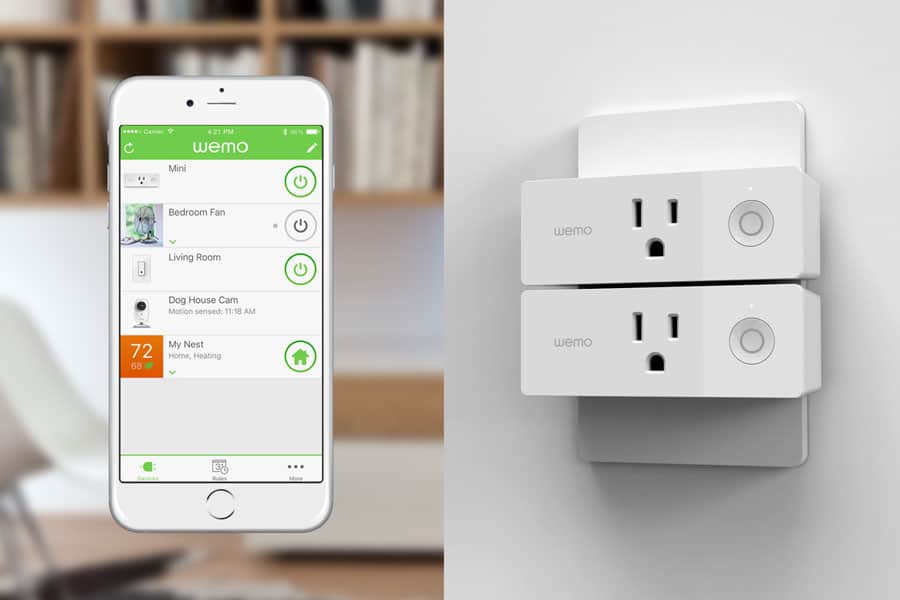Complete Guide to Voice Assistants - Most Popular Digital Helpers
AUTHOR: Carlos ParasUPDATED: November 20, 2023
Voice assistants like Amazon’s Alexa and Google Assistant are quickly becoming a standard feature throughout many smart home devices. From smart speakers and smart watches to smart TV’s and smart thermostats, these voice assistant-enabled devices are working their way into nearly every facet of our lives.
What is a voice assistant? A voice assistant is an automated software application or platform that allows users to interact with and control devices using simple voice commands. Voice assistants use the power of natural language processing, voice recognition technology, and speech synthesis to process commands and complete various tasks and functions.
In this article, I'll describe how speech recognition technology has evolved into the voice assistants that we know today. I’ll explain a few common misconceptions of voice assistants and give an overview of the most popular voice assistants that are currently available.
Smart Home Deals @ AmazonA Brief History of Speech Recognition Technology
It’s hard to believe, but the beginnings of the modern-day voice assistant started as early as 1952 with the creation of the Automatic Digit Recognition machine by Bell Labs. Nicknamed “Audrey”, the machine could recognize the spoken digits 0–9. It could achieve this feat with 90% accuracy, but only when the digits were spoken by its original creator K.H. Davis. Needless to say, Audrey’s use was extremely limited, but it was a significant breakthrough in speech recognition at the time.
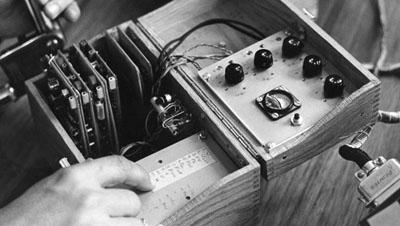
IBM Shoebox - Image Courtesy of: IBM
In 1961, the IBM Shoebox was introduced to the market. This machine was another important advancement in the development of speech recognition technology. Shoebox could recognize 16 words and the numbers 0-9. It could calculate simple arithmetic functions by recognizing command words like “plus”, “minus”, and “total”.
After the IBM Shoebox, several other machines followed and continued technology’s march towards the voice assistants we use today. In 1971, the US Department of Defense funded DARPA’s Speech Understanding Research program which led to the creation of Harpy, a machine that could recognize 1,011 words. In the 1980’s, IBM created Tangora, a voice activated typewriter that could recognize 20,000 words.
In 1990, the first speech recognition product for consumers was released by Dragon and came with a price tag of $9,000. The software, called DragonDictate, used “discrete speech" where the user had to pause between each spoken word. Dragon followed up in 1997, with Dragon NaturallySpeaking, the first continuous speech recognition product. It was offered at a much lower, albeit still expensive, price of $695.
Fast forward to today, and there are a half dozen mainstream voice assistants that are capable of far more than the IBM Shoebox or Harpy. Thanks to rapid advances in artificial intelligence and machine learning, today’s voice assistants are now able to perform tasks ranging from ordering products online and scheduling appointments to providing news updates and even helping users pay their bills.
Common Misconceptions of Voice Assistants
In recent years, many smart home devices have acquired the capability to be controlled by a voice assistant. Soon, voice assistants will be able to operate on almost any device. The rise of the Internet of Things (IoT) is driving a shift to a point where each and every household appliance will be connected and able to communicate with each other.
Just as it is helpful to define what a voice assistant is, it is just as helpful to understand what a voice assistant is not. First, voice assistants are not powered by the sort of artificial intelligence seen in science fiction. Unlike HAL 9000 from 2001: A Space Odyssey, today’s voice assistants are not capable of thinking or feeling, nor will they ever be able to do so.
Another misconception is that voice assistants are always listening. Most voice assistants, like Alexa and Google Assistant, will only start listening and recording audio when it hears their wake word, “Alexa” or “OK Google”. In addition, a light or indicator will turn on once the wake word is detected and while audio is being streamed to the cloud for processing.
Similarly, voice assistants are not capable of recording all of your conversations, although some do save recorded commands to improve their services (a feature which can easily be disabled by users).
Addressing misconceptions like these may seem silly, but many people are still avoiding the use of voice assistants because of privacy concerns. According to a recent survey by Accenture, 22% of people surveyed leave the room or lower their voice so their smart assistant can’t listen to their conversations. And 48% believe that their voice assistant is listening all the time.
As the use of virtual assistants and smart home devices becomes more popular, people will (hopefully) learn to trust that the technology in their home isn’t spying on them. Of course, trust is earned, not given. Manufactures need to invest more resources into developing higher security standards and they must continue to educate consumers as the technology improves.
We have only seen the beginning of how powerful and beneficial virtual assistants can be in our everyday lives. It would be a shame if the highest potential of this technology was not reached due to privacy concerns and misunderstandings about how the technology actually works.
Popular Voice Assistants
Speech recognition and machine learning has vastly improved since its humble beginnings, nearly 70 years ago. The technology has expanded and evolved into the voice assistants that are used in smart devices all over the world.
Here is a list of the most recognized and most popular voice assistants available today.
Amazon's Alexa
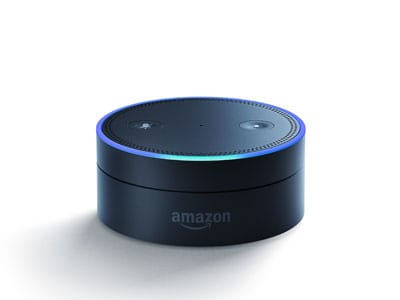
Amazon Echo Dot
Amazon’s Alexa was released with the Echo in 2014 and has gained wide spread popularity. This is due, in large part, to the numerous smart home devices offered by the online retail giant. Alexa is able to interact with user questions, play music or audiobooks upon request, and complete everyday tasks like making to-do lists or sharing weather updates.
In order to get access to these functionalities (among many others), users simply have to say the wake word, “Alexa” followed by their request. Alexa is able to access and control third party services and devices through software applications which Amazon calls “skills”. There are over 70,000 Alexa skills available in the Alexa Skills store and that number is continuously growing.
Nearly every smart home device on the market is compatible with Alexa or already has Alexa built-in. This gives users great flexibility when designing and creating a smart home automation and security system.
Google Assistant
Google Assistant, released in 2016, is an innovative voice assistant that is powered by Google’s proprietary artificial intelligence technology. Users reap the benefits of Google’s impressive computing and software expertise when interacting with Google Assistant.
This isn’t Google’s first attempt at a voice assistant. Google Now, which originally debuted back in 2012, was a created in answer to the release of Apple’s Siri. While Google Now was able to answer simple questions, it was not capable of engaging in two-way conversation, which is one of the areas where Google Assistant sets itself apart from other voice assistants.
Google Assistant can be found as a feature on all of Google’s flagship devices, including the Google Home Hub, the Google Home smart speaker, and Google Pixel phones. It is also available as an app for devices running the Android or iOS operating system.
In 2016 Google launched Actions on Google, a platform that allows developers to create apps for Google Assistant. Google provides an Actions Direction on the web or through its app on Android or iOS. The app directory boasts over 1 million actions available to configure and customize interactions with the Assistant.
Google released a software development kit in 2017 to provide third party developers a way to build their own devices that can run Google Assistant. With countless third party apps and multiple devices offering integration with Google Assistant, you can be sure to find many ways to enjoy the benefits of this voice assistant.
Apple’s Siri
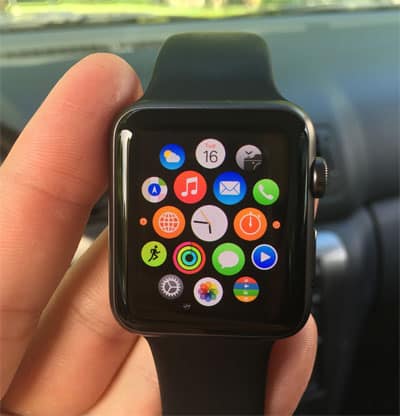
Apple Watch
Apple’s Siri was initially introduced on the iPhone 4S in 2011. Before appearing as a smartphone app, Siri began as a spin-off from another DARPA funded project, called the Cognitive Assistant that Learns and Organizes (CALO) project. A non-profit research institute named SRI International took the developments from the CALO project and began work on the first virtual personal assistant.
As progress continued, members of the SRI team eventually formed a new company, called Siri, Inc. That company was acquired by Apple in 2010 and Siri was integrated as a standard feature of Apple’s iOS operating system.
Today, Siri can perform tasks such as navigation, web search, event reminders, adjustment of device settings, plus many more. The voice assistant is now available on Apple devices such as the iPad Pro, the HomePod, and Apple Watch.
With Apple’s release of the HomeKit in 2014, smart home enthusiasts can now control their home automation devices through one central iOS device. And with Siri on board, functions and tasks can be performed with a series of voice commands.
Microsoft’s Cortana
Cortana is Microsoft’s digital voice assistant. It was originally developed for the Windows Phone 8.1 and is now available with the Windows 10 operating system. Since its introduction in 2014, the list of uses for Cortana has grown, and it is now present on devices ranging from Microsoft’s Xbox One gaming console to its noise-canceling Surface headphones, as well as the iOS and Android operating systems.
Initial development began in 2009 and the process included interviewing several human personal assistants. These interviews eventually led to the creation of several of Cortana's functions such as:
- Notebook – Cortana can store learned personal information such as interests, favorite places, home and work information, etc. With this info it can provide traffic information, track packages, adjust calendar appointments, and more, based on the information Cortana learns about you.
- Reminders – Cortana can set reminder notifications based on time, location, personal contacts, or emails. For example, you can have Cortana remind you to buy bread the next time you’re at the store or to make an important phone call at a certain time or even to say, “Happy Birthday” to your best friend the next time she calls.
Cortana is more than capable of handling everyday voice tasks like answering questions, web search, and music recognition and playback. Cortana also has a growing number of third party skills (similar to Alexa’s Skills).
Microsoft appears to be reorienting Cortana for very different use cases. According to recent reports, the team behind Cortana has realized that it has fallen behind Alexa and Google Assistant when it comes to features and supported devices. Cortana is quickly transitioning to a service that connects users to Microsoft 365 cloud services through Alexa, Google Assistant, and other Android or iOS applications.
While we have yet to see where this new approach will take Cortana, chances are this change will breathe new life into the once dwindling voice assistant.
Samsung’s Bixby
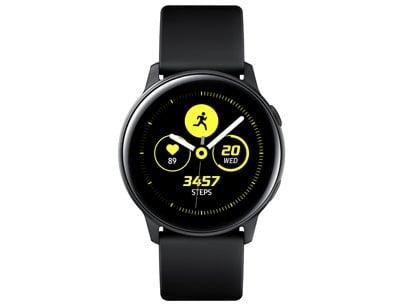
Samsung Galaxy Watch - Image Courtesy of: Samsung
Released in 2017 along with the Samsung Galaxy S8 and S8+, Samsung’s Bixby voice assistant is one of the newer options available to the market. Despite its youth, Bixby has been widely adopted by Samsung users. Similar to how Google Assistant was a reboot of the Google Now voice assistant, Samsung’s Bixby represents a reboot of S Voice, Samsung’s original voice assistant, which was released in 2012.
Samsung has taken an interesting approach with the introduction of multiple Bixby-related services. In addition to Bixby Voice, as the voice assistant is called, other services include Bixby Vision, which provides augmented reality functionality, and Bixby Home, which allows for smart homes to be created around the Bixby family of services.
Bixby Voice is intended as a means for Samsung users to perform tasks similar to what a personal assistant might perform. These include making reservations, getting tailored information (weather updates, meeting reminders, news, etc.), and completing basic actions like starting phone calls or editing a photo, all by using voice commands.
One unique feature manages to set Bixby apart from the rest of the pack of voice assistants. Bixby is able to learn individual voices, which allows it to customize its answers to questions depending on who is asking. As Samsung advertises, Bixby is able to learn, evolve, and adapt to its users.
IBM Watson
Unlike the other voice assistants, IBM Watson is a question/answering computer system that is able to answer almost any question it is asked, thanks to the success of IBM’s DeepQA project. While it is not as well-known as the other voice assistants mentioned, IBM Watson received most of its notoriety in pop culture from winning the game show Jeopardy! in 2011.
While other voice assistants are built on basic artificial intelligence technology, the software and systems behind IBM Watson are far more robust. Cutting-edge computer science techniques like information retrieval, knowledge representation, automated reasoning, and machine learning are all on display through IBM Watson’s stunning ability to answer complex questions rapidly and with a high degree of accuracy.
However, IBM Watson is capable of far more than just winning game shows. In 2014, the IBM Watson Group was formed, which aims to offer services backed by Watson’s impressive computing power to businesses and non-profits across all industries. These services include machine learning, natural language processing, visual recognition, and language translation.
As you can see, the variety of functions and tasks that voice assistants can manage is seemingly endless. What was once only possible using massive sized, mainframe computers can now be accomplished in the palm of your hand on a smartphone. I hope the information shared in this article will encourage you to integrate the benefits of voice assistants into your daily life.
Recommended Products
- Build relationships at work and home. Messenger and WhatsApp put you just one tap away from friends and family—even if they...
- A more natural connection. Smart Camera adjusts automatically so you can move freely and stay in frame, while Smart Sound...
- Call anyone, anywhere. Use apps like Messenger and WhatsApp to connect with friends and family—even if they don’t have a...
- Bigger screen, bigger sound. A brilliant 14” HD tilting display and a room-filling stereo speaker means you’ll never miss...
- Privacy by design. Easily disable the camera and microphone, or block the lens with the integrated camera cover.
No products found.
- Alexa can show you even more - With a 10.1" HD screen that’s designed to move with you, video calls, recipes, and shows are...
- Stay in frame - Video call friends and family or take a picture while the 13MP camera with auto-framing and motion keeps you...
- Smart home made simple - Set up compatible Zigbee and Matter devices without a separate hub. Ask Alexa to show you security...
- Take a look around when you’re away - Securely access the built-in camera to remotely monitor your home anytime with the...
- So much entertainment - Ask Alexa to play your favorite shows, music, and podcasts from Prime Video, Netflix, Amazon Music,...
- The speaker must be plugged into a wall outlet to function, Sound performance: Room-rocking bass and 360-degree, lifelike...
- Built-in Alexa: Amazon Alexa and Google Assistant are built into this smart speaker for hands-free voice control. And a...
- Connectivity: Pair your device to this home speaker to stream your favorite music and more via a Bluetooth connection, your...
- Control: Easily control your home speaker with three different ways to manage what you hear: your voice, the Bose Music app,...
- Make or take calls: With Alexa only, make or take calls from this smart speaker to Bose smart products, Amazon Echo products,...
- SOUND PERFORMANCE: Fill any room with impressive wall-to-wall stereo sound from a single speaker
- BUILT-IN-ALEXA: Amazon Alexa and Google Assistant are built into this smart speaker for hands-free voice control. And a...
- CONNECTIVITY: Pair your device to this home speaker to stream your favorite music and more via a Bluetooth connection, your...
- CONTROL: Easily control your home speaker with three different ways to manage what you hear: your voice, the Bose Music app,...
- MAKE OR TAKE CALLS: With Alexa only, make or take calls from this smart speaker to Bose smart products, Amazon Echo products,...
- SUPERIOR SOUND QUALITY - Experience deep bass and 360-degree lifelike sound for an immersive audio experience, no matter...
- SEAMLESS VOICE CONTROL - Effortlessly manage your music, set timers, and get information with built-in Amazon Alexa and...
- PORTABLE AND DURABLE DESIGN - Take your music anywhere with a rugged, water-resistant design and a convenient handle,...
- EXTENDED BATTERY LIFE - Enjoy up to 12 hours of continuous playtime on a single charge, allowing you to listen all day long...
- SMART HOME INTEGRATION - Control compatible smart home devices using just your voice, making it easy to adjust lights,...
No products found.
No products found.
- Enjoy an immersive audio experience - Echo Studio now features spatial audio processing technology for a wider and more...
- Voice control your music – Stream songs from Amazon Music, Apple Music, Spotify, Pandora, Tidal, and more. With Amazon...
- Adapts to any room – Automatically senses the acoustics of your space, fine-tuning playback for optimal sound.
- Built-in smart home hub – ask Alexa to control Zigbee and Matter-compatible devices.
- Ready to help – Ask Alexa to play music, read the news, and answer questions.
No products found.
No products found.
No products found.
- The durable, battery-powered smart speaker for outdoor and indoor listening
- Easy to use - Setup takes minutes, and control is simple with the Sonos app, Bluetooth, AirPlay 2, and your voice
- Wi-Fi and Bluetooth - Stream over Wi-Fi and connect Move to the rest of your Sonos system at home. Switch to Bluetooth when...
- Voice control - Amazon Alexa is built right in so on Wi-Fi you can play music, check news, set alarms, get your questions...
- Battery that lasts - Enjoy up to 11 hours of continuous play time and deep, powerful sound. Easily recharge Move on the...
- Sonos One - The powerful smart speaker with voice control built in.
- Brilliant sound - Get rich, room-filling sound with Sonos One, and control it with your voice, the Sonos app, Apple...
- Voice control - Amazon Alexa is built right in so you can play music, check news, set alarms, get your questions answered,...
- For every room - The compact design fits just about any space. Put it on your kitchen countertop or tuck it away on your...
- Stereo sound with two - Pair two Sonos Ones together in the same room for stereo separation and more detailed sound. Use a...
No products found.
- The durable, battery-powered smart speaker for outdoor and indoor listening
- Easy to use - Setup takes minutes, and control is simple with the Sonos app, Bluetooth, AirPlay 2, and your voice
- Wi-Fi and Bluetooth - Stream over Wi-Fi and connect Move to the rest of your Sonos system at home. Switch to Bluetooth when...
- Voice control - Amazon Alexa is built right in so on Wi-Fi you can play music, check news, set alarms, get your questions...
- Battery that lasts - Enjoy up to 11 hours of continuous play time and deep, powerful sound. Easily recharge Move on the...
No products found.
No products found.
No products found.
No products found.


